| Srl | Item |
| 1 |
ID:
138699
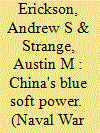

|
|
|
|
|
| Summary/Abstract |
On 3 September 2014, almost six years since Chinese warships first entered the Gulf of Aden to fulfill antipiracy duties, China Central Television (CCTV)–8 aired the first episode of “In the Gulf of Aden” . The multidozen-episode program, designed to “ignite raging patriotism” , given evening prime-time status, and attracting a popular audience with a star-studded cast, explores in dramatic fashion Beijing’s experience fighting modern piracy. Produced by the People’s Liberation Army Navy (PLAN) Political Department’s Television Art Center over three years, the series offers a unique window into how the PLAN has conducted its antipiracy mission and seeks to portray its experience to a Chinese audience.
|
|
|
|
|
|
|
|
|
|
|
|
|
|
|
|
| 2 |
ID:
114849
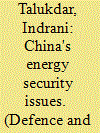

|
|
|
| 3 |
ID:
082381
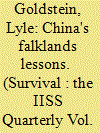

|
|
|
|
|
| Publication |
2008.
|
| Summary/Abstract |
The People's Liberation Army's lack of recent combat experience leads Chinese defence analysts to a major, systematic effort to look outward in the pursuit of insights about the emerging strategic environment. In Chinese military literature, the 1982 Falklands War has achieved noteworthy prominence. The PLA's objective and sophisticated understanding of the war in the South Atlantic may help explain both specific Chinese military approaches toward the analogous Taiwan situation and wider trends in Chinese military development
|
|
|
|
|
|
|
|
|
|
|
|
|
|
|
|
| 4 |
ID:
132840
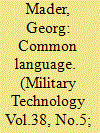

|
|
|
|
|
| Publication |
2014.
|
| Summary/Abstract |
Prior to Berlin's ILA Georg Mader takes a through look at updates and developments in the air arms of Austria, Germany and Switzerland.
|
|
|
|
|
|
|
|
|
|
|
|
|
|
|
|
| 5 |
ID:
129392
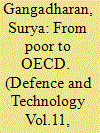

|
|
|
|
|
| Publication |
2012.
|
| Summary/Abstract |
You got to hand it to the South Koreans, in about three decades flat they've risen from developing / poor to OECD status. You can see it in Seoul's steel and glass power blocks punching through the skyline, in the style and obvious affluence on the streets (note the mind boggling prices).
|
|
|
|
|
|
|
|
|
|
|
|
|
|
|
|
| 6 |
ID:
129430
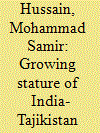

|
|
|
|
|
| Publication |
2014.
|
| Summary/Abstract |
'Tajikistan is a key partner of India in the Central Asian region' - Indian Prime Minister, Manmohan Singh, September 2012
The end of the Cold War, witnessed a dramatic transformation in the world order. India has concluded strategic partnership agreements with various regional and global partners such as the United States, Russia, France, Japan, Kazakhstan, Afghanistan, Uzbekistan etc. Tajikistan became the latest country to have concluded the strategic partnership agreement with India and the third among the Central Asian Republics (CARs) after Kazakhstan and Uzbekistan. The post-Cold War global strategic developments have brought India and Tajikistan closer to one another. Strategic partnership agreement makes a lot of sense when Tajikistan is considered India's gateway to Central Asia. Strategic partnership agreement is part of India's foreign policy goals to strengthen its presence in areas of interest to India and gaining
more strategic space. The agreement was signed during the visit of the President of the Republic of Tajikistan, Emomali Rahmon to India in September 2012. It was important in a way that it elevated the old close normal bilateral ties to strategic level. With this, both sides can now engage in a robust manner. The strategic importance of this partnership lies in sharing common perspectives on several international
and regional issues. In the 21st century, both sides would like to establish qualitatively new and mutually beneficial relations in the political, economic, military, development cooperation and in other areas.
|
|
|
|
|
|
|
|
|
|
|
|
|
|
|
|
| 7 |
ID:
192492
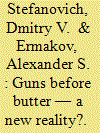

|
|
|
|
|
| Summary/Abstract |
Warfighting in Ukraine in 2022-2023 has become the first large-scale armed
conflict in Europe in the 21st century that directly involves Russia and
NATO. The scale of events, the geography of operations, the number of
weapons used and the personnel engaged require a reassessment of military
development and defense spending priorities in many countries around the
world. This article analyzes certain features of the current armed conflict
and the decisions already made by individual countries. The authors come
to the conclusion that given the scale of military buildup in Europe and
elsewhere it is advisable to think about new measures to reduce risks now
and establish effective arms control in the future.
|
|
|
|
|
|
|
|
|
|
|
|
|
|
|
|
| 8 |
ID:
129129
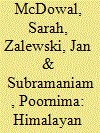

|
|
|
| 9 |
ID:
135468
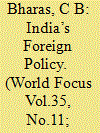

|
|
|
|
|
| Summary/Abstract |
Thus, it is clear that “With the gradual accretion of power by states such as China and India, the world may now be witnessing a major shift in power dynamics.” The Sino-Indian security relations shall have a tremendous impact on future and over all stability of Asia. When the security system of a state shall be at stake, when internal disturbance shall be cause of concern and in an environment of international terrorism, a security-centric national policy will of course, be given priority.
|
|
|
|
|
|
|
|
|
|
|
|
|
|
|
|
| 10 |
ID:
132791
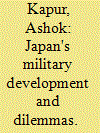

|
|
|
|
|
| Publication |
2014.
|
| Summary/Abstract |
Japan merits serious study as a diplomatic and strategic power in the twenty-first century for several reasons. Although her population size is declining because of shrinking birth rates and restrictive immigration, the ratio of seniors is increasing --with increasing demands for pensions and state-supported safety nets - and the number of younger participants in the growth of her economy and public life is declining, the Japanese people have demonstrated a high degree of discipline and internal social cohesion at times of war, peace and crisis. An example is their fortitude during the recent (2011) nuclear and tsunami disasters. After 1945, her social and political values stress the importance of harmony and consensus building in her domestic arrangements, and the Japanese people and ruling elites value rejection of war as the sovereign right of the Japanese state. For this reason, domestic public opinion matters in the making and orientation of Japan 's external policies following her defeat in 1945 and with the establishment of a pacifist constitution and constitutional democracy. The population is not easily swayed by radical political and nationalistic rhetoric, even though in recent years, nationalist sentiment has grown in Japan and this was signalled by the election of Prime Minister S/2in;o Abe (2012). Still, despite the centre-right tilt in Japanese public and elite opinion in recent years, the Japanese people demand a thorough assessment of new moves to shift strategic policy and constitutional arrangements on defence issues.
|
|
|
|
|
|
|
|
|
|
|
|
|
|
|
|
| 11 |
ID:
038709


|
|
|
|
|
| Edition |
2 ed.
|
| Publication |
London, Cassell and Company Ltd, 1967.
|
| Description |
x, 433p.: ill.Hbk
|
|
|
|
|
|
|
|
|
|
|
|
Copies: C:1/I:0,R:0,Q:0
Circulation
| Accession# | Call# | Current Location | Status | Policy | Location |
| 001376 | 928.41/HAR 001376 | Main | On Shelf | General | |
|
|
|
|
| 12 |
ID:
185315
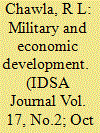

|
|
|
| 13 |
ID:
149719


|
|
|
|
|
| Summary/Abstract |
As attention focuses on other conflicts and threats, the disputed India-China border remains a potentially serious flashpoint. Brian Cloughley and Caron Natasha Tauro examine the balance of forces and the wider strategic implications of the dispute.
|
|
|
|
|
|
|
|
|
|
|
|
|
|
|
|
| 14 |
ID:
106793
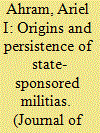

|
|
|
|
|
| Publication |
2011.
|
| Summary/Abstract |
This article uses a sequential mixed method approach to examine the origins and persistence of paramilitaries and state-sponsored militias in the developing world. Combining comparative case studies of Southeast Asia and the Middle East with statistical analysis, it shows that revolutionary decolonization produces more decentralized and localized force structures, while direct inheritance of colonial armies leads to more conventional force structures. Subsequently, the level of competition within the regional system influences whether a state can persist in the use of paramilitaries or must transition to a more centralized, conventional force.
|
|
|
|
|
|
|
|
|
|
|
|
|
|
|
|
| 15 |
ID:
021368
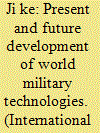

|
|
|
|
|
| Publication |
April 2002.
|
| Description |
22-30
|
|
|
|
|
|
|
|
|
|
|
|
|
|
|
|
| 16 |
ID:
130030
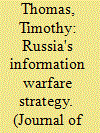

|
|
|
|
|
| Publication |
2014.
|
| Summary/Abstract |
This article discusses new developments in Russia's information and cyber warfare concepts. It updates information based on old paradigms and introduces several new developments that are influencing the current paradigm. It examines the potential shape of Russia's cyber strategy and offers a prediction as to how they might 'cyber cope' in future conflict.
|
|
|
|
|
|
|
|
|
|
|
|
|
|
|
|
| 17 |
ID:
130141
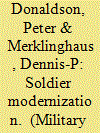

|
|
|
|
|
| Publication |
2013.
|
| Summary/Abstract |
Soldier modernization At least 46 countries have some kind of formally-acknowledged soldier modernisation programme. What's more, it is probably safe to assume that every nation state that puts its young people in uniform has at least the intention of equipping them with modern technologies, making them more effective in combat against a perceived enemy.
|
|
|
|
|
|
|
|
|
|
|
|
|
|
|
|
| 18 |
ID:
077931
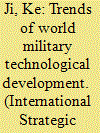

|
|
|